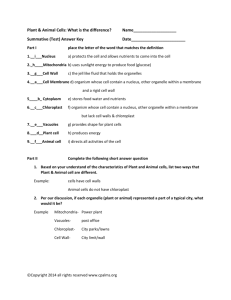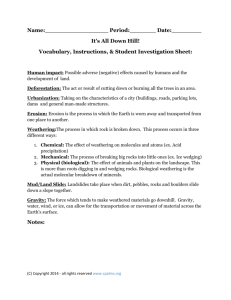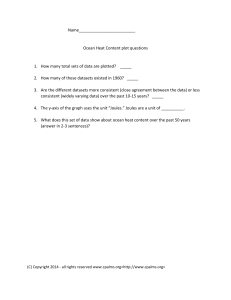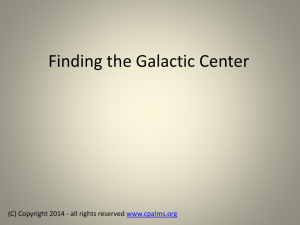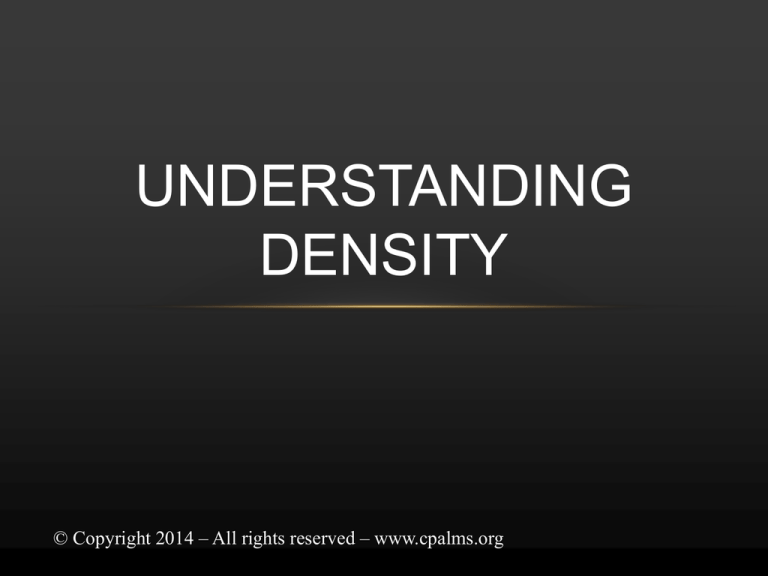
UNDERSTANDING
DENSITY
© Copyright 2014 – All rights reserved – www.cpalms.org
WHAT IS MATTER?
• Before we learn what density is, we need to review what
matter is.
• Basically, everything in the universe can be divided into two
broad categories – Matter or Energy.
• Matter is anything that has mass and takes up space.
• Energy has no mass and does not take up any space.
© Copyright 2014 – All rights reserved – www.cpalms.org
WHAT IS MATTER?
• For example, water is matter because it has mass and takes
up space.
• We can measure the mass by using a balance, and we can
measure its volume by using a graduated cylinder.
• On the other hand, light is Energy. It has no mass and does
not take up any space.
• Can you measure light on a balance? Does light take up
space?
© Copyright 2014 – All rights reserved – www.cpalms.org
WHAT IS MATTER?
• What about air? Is air Matter or Energy?
• Well, even though we can’t see air, we can still apply our
test.
• Does air take up space?
• Yes, a balloon proves that air takes up space.
• Does air have a mass?
• Yes, if we had a sensitive enough balance, we would find
that a balloon filled with air has a greater mass than an
empty balloon.
© Copyright 2014 – All rights reserved – www.cpalms.org
PROPERTIES OF MATTER
• Matter has both physical properties and chemical
properties.
• Physical Properties – Are properties that can be observed or
measured without changing the chemical makeup of matter.
• For example: size, color, smell, melting point and boiling
point are all physical properties. Observing or measuring
them does not change the matter from one substance to
another.
© Copyright 2014 – All rights reserved – www.cpalms.org
WHAT IS DENSITY?
• Density is another important physical property of matter.
• Density is a comparison of how much matter there is in a
certain amount of space.
• It is a relationship between mass and volume.
• It can be expressed by the formula:
mass
density = ─────
volume
© Copyright 2014 – All rights reserved – www.cpalms.org
WHAT IS DENSITY?
• For example, which one of the squares below is
more dense?
Square A
Square B
© Copyright 2014 – All rights reserved – www.cpalms.org
WHAT IS DENSITY?
• Hopefully, you see that square B is more dense.
Square A
Square B
© Copyright 2014 – All rights reserved – www.cpalms.org
WHAT IS DENSITY?
• Remember the equation?
mass
density = ─────
volume
The volumes are equal (squares are the same size)
© Copyright 2014 – All rights reserved – www.cpalms.org
WHAT IS DENSITY?
• Remember the equation?
mass
density = ─────
volume
The masses are different (Square B has more particles)
© Copyright 2014 – All rights reserved – www.cpalms.org
WHAT IS DENSITY?
• How about this? Now which square is more dense?
Square A
Square B
© Copyright 2014 – All rights reserved – www.cpalms.org
WHAT IS DENSITY?
• Hopefully, you see that Square B is more dense. It
has the same amount of matter (mass) in a
smaller space.
Square A
Square B
© Copyright 2014 – All rights reserved – www.cpalms.org
CALCULATING DENSITY?
• As stated above, density can be calculated by using
the formula:
density = mass/volume
• The standard units used in density are:
• Mass is measured in grams (g)
• Volume is measured in cubic centimeters (cm3)
• Therefore, density is expressed in g/cm3.
© Copyright 2014 – All rights reserved – www.cpalms.org
EXAMPLES
• Jack has a rock. The rock has a mass of 6g and a
volume of 3cm3. What is the density of the rock?
d = 6g/3cm3 = 2g/cm3
• Jill has a gel pen. The gel pen has a mass of 8g and
a volume of 2cm3. What is the density of the pen?
d = 8g/2cm3 = 4g/cm3
© Copyright 2014 – All rights reserved – www.cpalms.org
WHY DO WE CARE?
• Since the measurement is standard, we can use it to
identify an unknown substance.
• Example – You buy what you think is a gold
chain. How can you be sure?
• Compute the density. If it matches the known
density for gold then it is real gold. If not, it is
probably fake.
© Copyright 2014 – All rights reserved – www.cpalms.org
WHY DO WE CARE?
• We can also use it to predict how substances will
interact. For instance, whether an object will sink or
float.
• The density of water is 1.0 (It is the standard to
which all other densities are compared)
• If the density of an object is greater than 1.0, the
object will sink in water.
• If the density of an object is less than 1.0, then the
object will float in water.
© Copyright 2014 – All rights reserved – www.cpalms.org
UNDERSTANDING DENSITY
• Any Questions?
© Copyright 2014 – All rights reserved – www.cpalms.org


